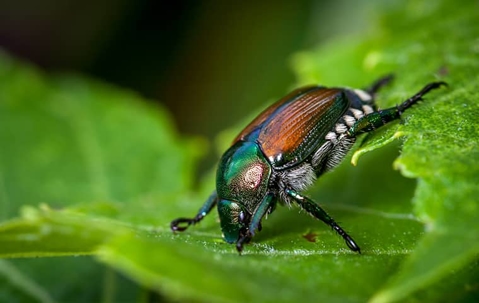Identification
During the last month I’ve been getting my fair share of questions about Japanese beetles. This beetle is known to be the most devastating pest of urban landscape plants in the Eastern United States. The Japanese beetles were first found in the United States in 1916 in New Jersey. Before, it was known only to occur in Japan where it is not considered a major pest. The Saint Clair area of Michigan provides a great climate, large areas for developing grubs, and hundreds of different plants for the adults to feed on. There are also no natural effective enemies to control these beetles. All these conditions make it possible for the Japanese beetle to continue to thrive.
Adult Japanese beetles are a brilliant metallic green averaging 3/8 inch long and around 1/4 inch wide. The wings are a coppery color and the abdomen has five tufts of white hair on each side. The larvae are white grubs that are C-shaped when disturbed. The first instar larvae are about 1/16 inch long in length. The more mature third instars are around 1-1/4 inch in length.
Life Cycle And Habits
Here in Michigan and the eastern part of the United States adult Japanese beetles emerge from the ground in the later part of June through July. They start feeding immediately on suitable plants while leaving a pheromone scent to attract more adult beetles. Sexual females leave a sex pheromone to attract males to start the mating process. After feeding and mating in the later afternoon females burrow into the ground 2-4 inches laying 1-5 eggs. They then returning to the surface to start this process all over again. This cycles continues until the adult females lay between 40 to 60 eggs.
Shortly the eggs form to white grubs and start feeding on roots and organic material. The white grubs grow rapidly by late September and in October they’re in the third instar stage. They dig deeper into the soil during the winter. These white grubs can survive in almost any soil in which plants can live. In the following spring, usually April, when the soil temperature begins to warm, the grubs begin to make their way to the surface. Now, back in the root zone, 1-3 inches in the soil they feed for 4 -6 weeks. The grubs pupate in an earthen cell and remain there until emerging as adults. The process from eggs to adult beetles is around 10 months.
Control And Prevention
It’s important to note that you must control adults as well as grubs for the treatment to be effective. Because Japanese beetles are attracted to plants they favor from a distance, only treating white grubs is not effective.
Controlling White Grubs
Buying a product called Milky Spore attacks the white grube continually over time. This spore is eaten by the Japanese beetle grubs. Once they feed on the spore, the bacterium from the Milky Spore kills the grubs. The spore count must build up for 2 to 3 years to be very effective. It’s important not to use an insecticide on the grubs that are needed to complete the bacterium cycle. Using Milky Spore is a long term control that is needed if you want to win the fight against Japanese beetles.
Adult Control
Removing beetles by hand may be effective on small plants and when beetle numbers are low. The presence of beetles on your plants attracts more beetles. Studies found that shaking them off in the early morning or later evenings into soapy water works best. Also, covering your plants with very fine netting in the peak adult months is another helpful control method.
Many different products like Sevin, Safer BioNeem, and Merit are available to help you treat Japanese Beetles around your home. With any of the products you use, make sure to thoroughly treat all foliage and flowers on the plants. While spraying, it’s important to treat high to mid range of the plants you’re treating. Do NOT treat directly on the ground or the base of the plants. Also, while treating move quickly and avoid treating in the wind. The reason for this is you’re trying to only kill the adults. You don’t want to disrupt the Milky Spore or grub product. If you’re killing the grubs, then they’re not eating the Milky Spore which results in slowing or stopping the bacterium cycle. During the heavy adult activity periods you might have to re-apply treatment depending on the amount of activity your property is getting.
How Not To Treat Japanese Beetles
Many studies have shown that using baits for Japanese beetles actually attracts more beetles instead of killing them. Yes, baits do kill these beetles, but the numbers say that you’re actually bringing more beetles to your property rather than killing.
New Landscaping
If you’re redoing or starting from a new piece of property, check out this table for plants Japanese beetles like and dislike. Adding more plants they dislike on your grounds would be ideal to avoid having a Japanese beetle problem to begin with.
If you're dealing with Japanese beetles on your property, give us a call at Eco Pest Control. With home pest control and commercial pest management offerings, we have the solution you need to keep these pests out for good!

